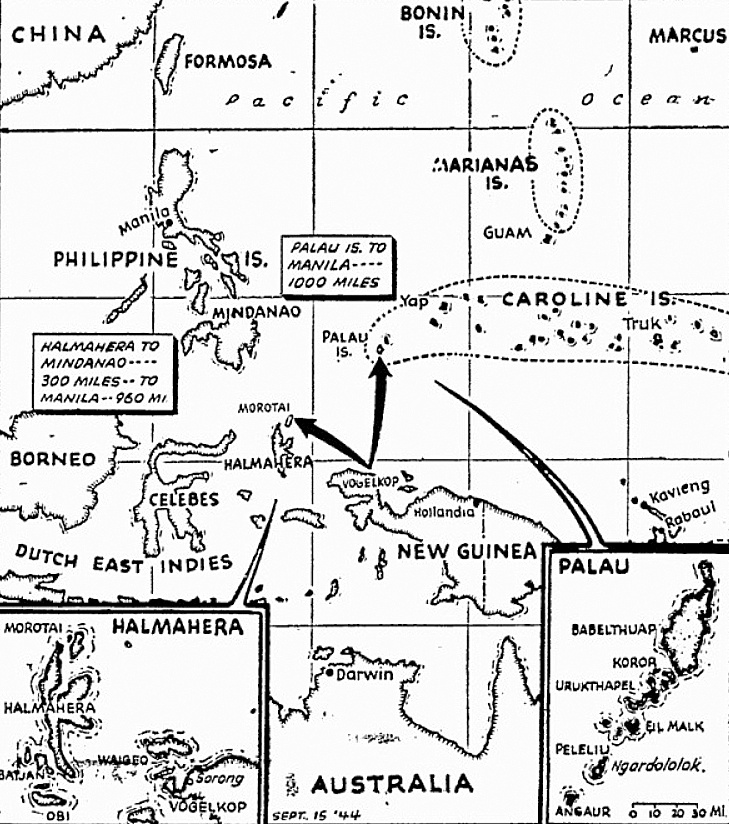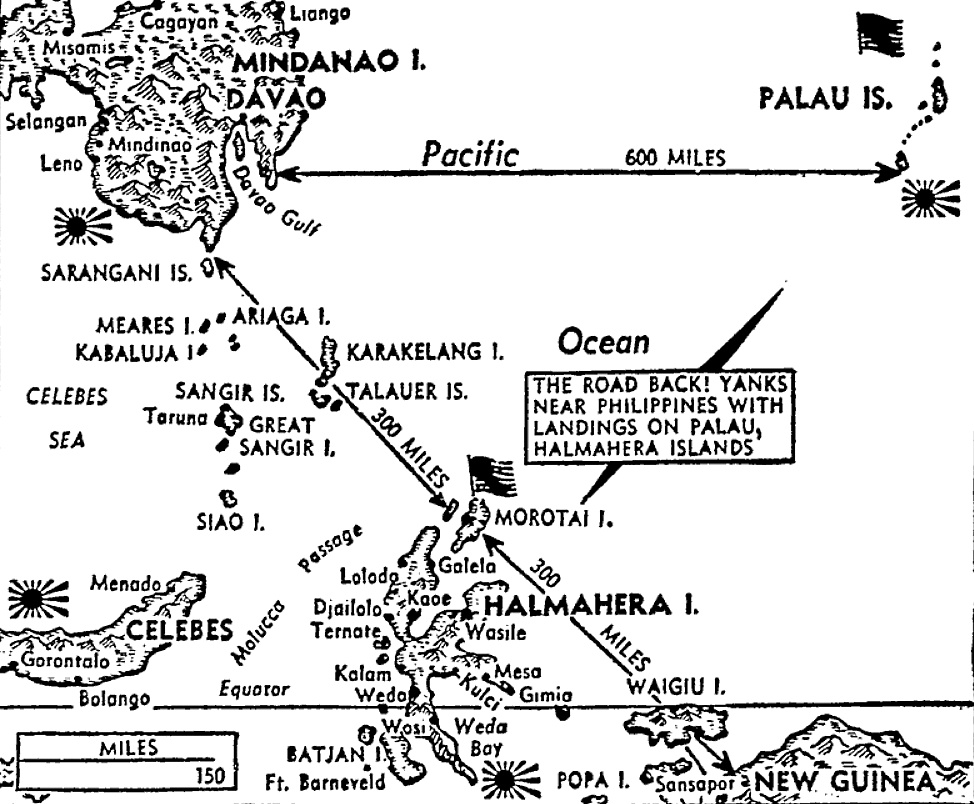The Pittsburgh Press (September 15, 1944)
Yanks invade two Jap isles
Big invasion armada pours troops into Palau and Morotai
By Frank Tremaine, United Press staff writer
Drive toward the Philippines by U.S. forces was underway today from two directions, as U.S. troops landed on Morotai Island, northernmost of the Halmahera group south of the Philippines, and went ashore on the Palau Islands, to the east.
Pearl Harbor, Hawaii –
A big American invasion armada poured fighting men ashore on the Jap island base of Palau, 560 miles east of the Philippines, today as Gen. Douglas MacArthur’s troops stormed up into the Halmahera Islands from the south in a twin offensive to clear the road back to Bataan and Corregidor.
Exploding their greatest combined offensive of the Pacific war, Gen. MacArthur and Adm. Chester W. Nimitz, commander-in-chief of the U.S. Pacific Fleet, breached the coastal defenses of the two island bastions under cover of shattering bombardments from sea and sky.
Gen. MacArthur led his troops ashore early Friday on Morotai Island, northernmost of the Halmaheras and only 250 miles south of the Philippines, at almost the same moment Adm. Nimitz’s Marines and Army assault units were battling across the beaches of Palau.
Gen. MacArthur issued a statement from the Morotai beachhead a few hours after the landing saying that “we now dominate the Moluccas” and “our position here is now secure and the immediate operation has achieved its purpose.” He added that “defeat now stares Japan in the face” and the campaign is entering its decisive phase.
A Navy communiqué said a number of beachheads were established on Palau, a narrow chain of 26 islands, many of them mountainous, lying between the Carolines and the Philippines. Babelthuap is the principal islet in the group.
Because of time difference, Adm. Nimitz’s announcement said the Palau landing occurred Thursday morning, Honolulu Time, which would be Friday morning Halmahera Time.
The twin invasion blow threatened to break the chain of sprawling island bases established by the Japs around the Philippines and the western and southern approaches to the Chinese mainland, and first reports from Palau said the enemy was fighting back furiously from long-prepared defenses.
U.S. battleships, cruisers and supporting warships of the Pacific Fleet stood offshore bombarding the Jap shore installations while carrier-based aircraft dive-bombed and strafed the enemy in close support of the advancing ground troops.
“Enemy defenses are being heavily bombed and shelled at close range,” the communiqué said.
Gen. MacArthur’s men on Morotai also went in under a powerful warship and aircraft screen, but their landing met only feeble Jap opposition, and casualties in the initial assault were described officially as “very light.”
The bulk of the Jap garrison in the Halmaheras were revealed to have been concentrated in the southern part of the island group in the belief that Gen. MacArthur would strike there. Instead, they were bypassed, cut off from their only direct sources of supply, and left to surrender or die.
On Palau, however, one of the toughest battles of the Pacific campaign was believed in progress, possibly exceeding in savagery the epic fight for Saipan or the Marine landing on Tarawa.
The troops who swarmed ashore had to overcome obstacles of barbed wire on the beaches, backed up by entrenched machine-gun positions. Farther inland were larger guns, probably ranging up to six inches, and the deadly mortars which caused heavy casualties on the Mariana Island beachheads.
A brief Navy communiqué said reinforcements were being put ashore from a host of transports guarded by the guns and planes of Adm. William F. Halsey’s Third Fleet, and that the landings were “continuing against stiff ground opposition.”
The reference to “ground” opposition indicated that the bulk of Palau’s aerial defenses had been smashed by Adm. Halsey’s task force in a series of softening up bombardments that began on Sept. 5 and continued almost without interruption until the zero hour.
The exact point of the landing was not disclosed, but Radio Tokyo said the attack centered on Peleliu Island, southernmost of the chain of atolls comprising the Palau group. Tokyo said the landing was made at 6:00 a.m. (Palau Time) and that the Jap garrison drove the Americans back into the sea after a two-hour battle.
“About 2,500” American dead were left on the beach, the broadcast said.
The language of the Pearl Harbor communiqué left little doubt the Japs would make a desperate attempt to hold Palau, probably their most important bastion in the Central Pacific, outranking even Truk, 1,150 miles to the west.
There was no mentioned of Jap opposition in the air, although there was a possibility that enemy might risk units of their grand fleet in an attempt to run carrier aircraft to the aid of their island garrisons.
Any such move, however, almost certainly would bring on a major battle of surface ships for which Adm. Halsey is undoubtedly well prepared. The size of the supporting battle fleet covering the Palau landing was not divulged, but it was known to include some of the Navy’s heaviest units.
The landing followed more than a week of widespread naval and air assaults by Adm. Halsey’s battlewagons and carriers against Jap positions on Palau and in the Central Philippines that cost the enemy 501 planes and scores of merchant vessels.
Truk bypassed
U.S. occupation of the Palaus would close a watery trap around 75,000 to 100,000 Jap troops now bypassed in the Western Carolines, including the once-formidable naval base at Truk.
In addition, it would remove the last island barrier astride the Central Pacific route to the Philippines and enable Adm. Nimitz to throw the full weight of his land, sea and air forces against the Jap-occupied islands.
VAdm. Theodore S. Wilkinson of Rosslyn, Virginia (commander of
the U.S. Third Amphibious Force), was directing the landing operations, while Marine Maj. Gen. Julian C. Smith of Alexandria, Virginia, who commanded the 2nd Marine Division at Tarawa, led the expeditionary troops.
Win air base*
The 300-mile overwater thrust from Dutch New Guinea to Morotai cleared away the last important barrier on Gen. MacArthur’s road back to the Philippines and gave his gathering air forces fighter bases within one hour’s flight of the southern up of the latter islands.
Gen, MacArthur watched the preliminary bombardment of Morotai from the bridge of a U.S. cruiser and went ashore in the wake of his troops to inspect the Pitoe Airdrome, one of the first prizes taken on the island’s southern coast.
“We shall shortly have an air and light naval base here within 300 miles of the Philippines,” he told his officers.
Pitoe Field is about 40 miles from the northern tip of Morotai.
“They are waiting there for me,” he added. “It has been a long time.”
Japs face trap
A triumphant communiqué announcing the invasion of Morotai declared that the Halmahera-Philippines line has now been penetrated, imperiling all of the remaining Jap conquests in the South Seas and threatening to isolate the enemy’s 16th and 19th Armies, some 200,000 strong, in the East Indies.
Envelopment of these armies, the communiqué said, “would sever the vital supply lines to the Japanese mainland of oil and other war essentials.”
Gen, MacArthur told his troops at the Pitoe Airdrome:
You have done well. You now dominate the last stronghold which bars the way to the Philippines. The enemy, as usual, was not in the right place at the right time.
Morotai Island, 12 miles off the northern tip of Halmahera, is 40 miles long, with a narrow coastal strip rising steeply to 4,000-foot, densely-wooded mountains, and had a native population of about 10,000 before the Japs seized it from the Dutch.
The initial landing was made at the southwestern end of the island, within a few hundred yards of Pitoe Airfield.
New record set for Navy release
Pearl Harbor, Hawaii (UP) –
The Navy established a new record for speed in announcing Pacific operations, disclosing the invasion of Palau approximately nine hours after U.S. troops hit the beaches.

